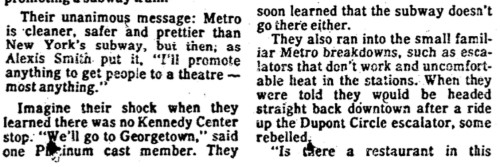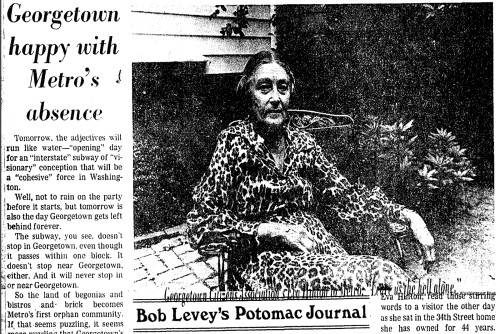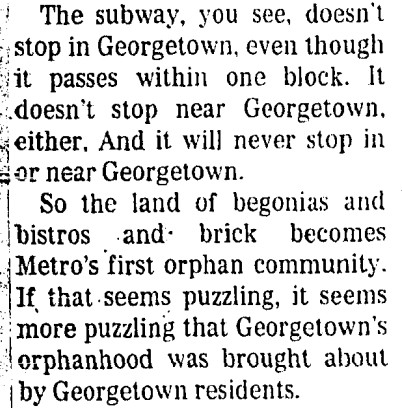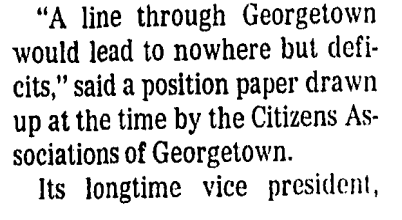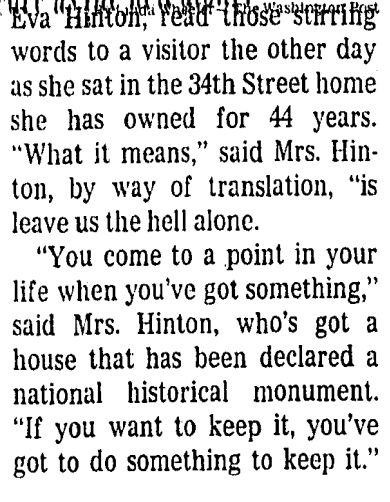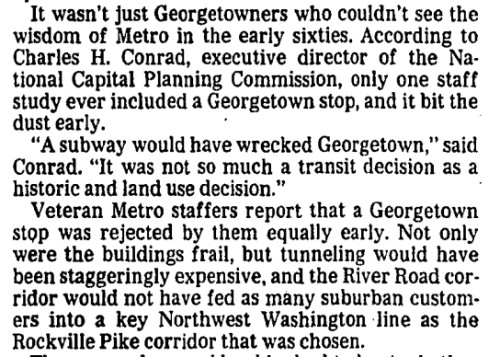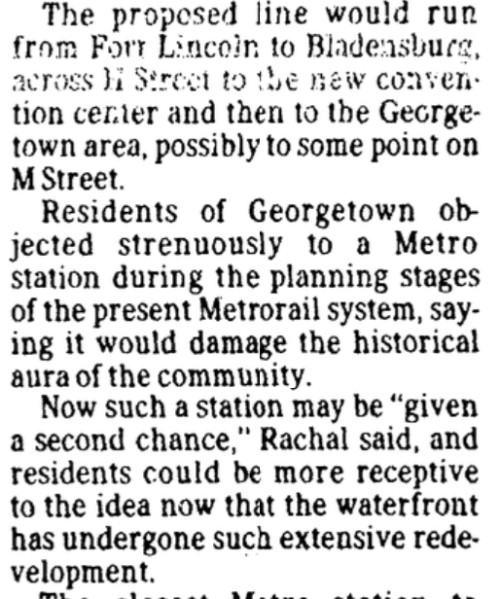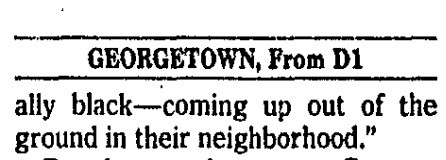How the urban legend of Georgetown residents halting a Metro stop came to be

A banner ad in the Washington Star from June 26, 1977.
This article was first published by the Georgetown Metropolitan.
Let’s first get this out of the way: The reason there is no Metro stop in Georgetown is two-fold. First, there were technical difficulties from the hardness of the bedrock and the proximity of the river which meant a station would be infeasible. Second, at the time the Metro planners were laying out the system, Georgetown was not enough of a population or job center to justify working out a solution to the feasibility problem.
This explanation is the one settled upon by Zachary Schrag, the unofficial historian of Metro. As you will see below, this is a conclusion shared by those who were actually involved with the planning. You will note that it does not include any reference to Georgetown residents thwarting the station in order to keep out people of color. Yet, this is an incredibly common belief, enough so to qualify as one of the great urban legends of the District, alongside such chestnuts as the reason there’s no J Street is that Pierre L’Enfant hated John Jay.
An obvious explanation for where this urban legend came from and why it persists is that it so conforms with what many people think of Georgetown residents. “Of course Georgetowners stopped Metro to keep out people of color, that’s just the sort of thing Georgetowners would do,” goes the reasoning. This probably explains why the legend persists, but there’s a bit more to the story of where the legend came from in the first place.
No contemporaneous mentions
I researched the archives of the Washington Post and the Washington Star, looking for contemporaneous mentions of local opposition to a Metro stop in Georgetown. Throughout the period of the planning of Metro (i.e. the 1960s through to the systems opening in 1976), I could not find one example.
Early mentions of the absence of a Metro stop in Georgetown reflect the truth, namely that it just was either too difficult or not a high enough priority. In an August 23, 1977 article, the Washington Star answered some frequently asked questions about the still relatively new system. One was about Georgetown:
Later in 1978, the absence of a Georgetown station is described more as a quirk than a conspiracy. The article in the Washington Star, describes a theater troupe from New York traveling around Metro to promote the new night service:
It’s possible that there is discussion of resident opposition in the archives of the Northwest Current or the Georgetowner, both of which were published at the time, but I did not have an opportunity to search those archives.
As described below (and in Schrag’s book), there was certainly some opposition to a Metro stop in Georgetown. But it wasn’t an unusual thing—lots of neighborhoods expressed misgivings about the planned subway—and it wasn’t significant enough to be discussed.
Patient zero
As far as I can determine, the first mention of Georgetown “blocking” a Metro station came in a piece by Bob Levey in the Washington Post on June 30, 1977.
The article is primarily from an interview with Eva Hinton, a legendary force in history of Georgetown planning. Regardless of the real reasons Metro skipped Georgetown, Hinton takes full credit.
And specifically:
It is true that there was some opposition to a Metro stop in Georgetown. But the records documented by Schrag demonstrate that it was never a distinct possibility. Hinton was taking credit for something that she and her organization had little role in bringing about.
Later in the piece, Levey actually explains how citizen opposition was fairly immaterial to the decision:
The reference to River Road actually reflects how the early plans that actually did consider a Georgetown stop put the stop on the Red Line. It would have meant sending the Red Line down Wisconsin Avenue south of Tenleytown. This was rejected due to the far great potential for growth along Connecticut Avenue.
So even though Levey undercuts Hinton’s misanthropic boasting, the legend was off and running. By the early 80s, it was already “well known” that Georgetown residents nixed a Georgetown stop. On September 17, 1980, the Washington Star published an article about the possibility of a new cross-town subway line:
It should probably bring some amount of depression to those, like me, who are hopeful for the construction of a new cross-town subway line to hear that the discussions of such a line have been going on, intermittently, for nearly 40 years.
An article in the Washington Post in 1985 continued the spread of the legend.
The legend had become firmly held fact by the time in 1994 when the Post published another story about the necessity for a new crosstown subway line:
A former Metro spokesman, a former mayor, and a Post reporter all repeating the legend as a verifiable fact will do a lot to spread it. It’s likely why longtime residents will say they are certain the reason there’s no Metro stop in Georgetown was the residents. Why would they think differently?
Truth putting on its boots
There’s an old saying about how a lie is halfway around the world before the truth even gets its boots on. In the case of this particular legend, the lie had several decades worth of a head start before Schrag set the record straight in his 2006 book on the creation of Metro, The Great Society Subway. This work eventually fueled a bevy of blog posts (such as this, that and the other) trying to push back on the urban legend, but it’s somewhat of a futile effort. It’s still a rather commonly held belief that people like Hinton kept out Metro. She surely would take great pride in that.
So the truth of the matter is that Georgetown residents didn’t block a Metro station, but they did take credit for the victory notwithstanding the lack of a fight. Couple this with the fact that many area residents were and are completely predisposed to believe the legend, and you’ve got yourself a perpetual motion machine.


